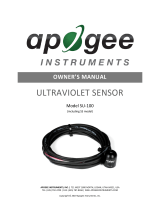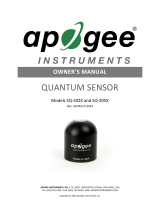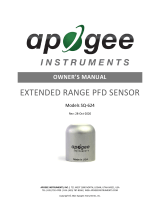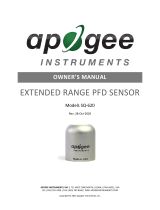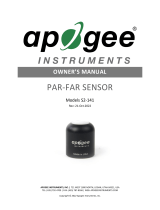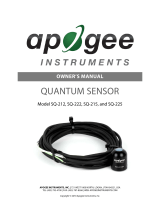Page is loading ...

APOGEE INSTRUMENTS, INC. | 721 WEST 1800 NORTH, LOGAN, UTAH 84321, USA
TEL: (435) 792-4700 | FAX: (435) 787-8268 | WEB: APOGEEINSTRUMENTS.COM
Copyright © 2023 Apogee Instruments, Inc.
OWNER’S MANUAL
QUANTUM SENSOR
Model SQ-422X
Rev: 17-Oct-2023

TABLE OF CONTENTS
Owner’s Manual ............................................................................................................................................................................... 1
Certificates of Compliance ....................................................................................................................................................... 3
Introduction ............................................................................................................................................................................. 5
Sensor Models ......................................................................................................................................................................... 6
Specifications ........................................................................................................................................................................... 7
Deployment and Installation .................................................................................................................................................... 9
Cable Connectors ................................................................................................................................................................... 11
Operation and Measurement ................................................................................................................................................ 11
Maintenance and Recalibration ............................................................................................................................................. 20
Troubleshooting and Customer Support ................................................................................................................................ 22
Return and Warranty Policy ................................................................................................................................................... 23

CERTIFICATE OF COMPLIANCE
EU Declaration of Conformity
This declaration of conformity is issued under the sole responsibility of the manufacturer:
Apogee Instruments, Inc.
721 W 1800 N
Logan, Utah 84321
USA
for the following product(s):
Models: SQ-422X
Type: Quantum Sensor
The object of the declaration described above is in conformity with the relevant Union harmonization legislation:
2014/30/EU Electromagnetic Compatibility (EMC) Directive
2011/65/EU Restriction of Hazardous Substances (RoHS 2) Directive
2015/863/EU Amending Annex II to Directive 2011/65/EU (RoHS 3)
Standards referenced during compliance assessment:
EN 61326-1:2013 Electrical equipment for measurement, control, and laboratory use – EMC requirements
EN 63000:2018 Technical documentation for the assessment of electrical and electronic products with
respect to the restriction of hazardous substances
Please be advised that based on the information available to us from our raw material suppliers, the products
manufactured by us do not contain, as intentional additives, any of the restricted materials including lead (see
note below), mercury, cadmium, hexavalent chromium, polybrominated biphenyls (PBB), polybrominated
diphenyls (PBDE), bis (2-ethylhexyl) phthalate (DEHP), butyl benzyl phthalate (BBP), dibutyl phthalate (DBP), and
diisobutyl phthalate (DIBP). However, please note that articles containing greater than 0.1 % lead concentration
are RoHS 3 compliant using exemption 6c.
Further note that Apogee Instruments does not specifically run any analysis on our raw materials or end products
for the presence of these substances, but we rely on the information provided to us by our material suppliers.
Signed for and on behalf of:
Apogee Instruments, October 2023
Bruce Bugbee
President
Apogee Instruments, Inc.

CERTIFICATE OF COMPLIANCE
UK Declaration of Conformity
This declaration of conformity is issued under the sole responsibility of the manufacturer:
Apogee Instruments, Inc.
721 W 1800 N
Logan, Utah 84321
USA
for the following product(s):
Models: SQ-422X
Type: Quantum Sensor
The object of the declaration described above is in conformity with the relevant UK Statutory Instruments and
their amendments:
2016 No. 1091 The Electromagnetic Compatibility Regulations 2016
2012 No. 3032 The Restriction of the Use of Certain Hazardous Substances in Electrical and Electronic
Equipment Regulations 2012
Standards referenced during compliance assessment:
BS EN 61326-1:2013 Electrical equipment for measurement, control, and laboratory use – EMC requirements
BS EN 63000:2018 Technical documentation for the assessment of electrical and electronic products with
respect to the restriction of hazardous substances
Please be advised that based on the information available to us from our raw material suppliers, the products
manufactured by us do not contain, as intentional additives, any of the restricted materials including lead (see
note below), mercury, cadmium, hexavalent chromium, polybrominated biphenyls (PBB), polybrominated
diphenyls (PBDE), bis (2-ethylhexyl) phthalate (DEHP), butyl benzyl phthalate (BBP), dibutyl phthalate (DBP), and
diisobutyl phthalate (DIBP). However, please note that articles containing greater than 0.1 % lead concentration
are RoHS 3 compliant using exemption 6c.
Further note that Apogee Instruments does not specifically run any analysis on our raw materials or end products
for the presence of these substances, but we rely on the information provided to us by our material suppliers.
Signed for and on behalf of:
Apogee Instruments, October 2023
Bruce Bugbee
President
Apogee Instruments, Inc.

INTRODUCTION
Radiation that drives photosynthesis is called photosynthetically active radiation (PAR) and is typically defined as
total radiation across a range of 400 to 700 nm. PAR is often expressed as photosynthetic photon flux density
(PPFD): photon flux in units of micromoles per square meter per second (µmol m-2 s-1, equal to microEinsteins per
square meter per second) summed from 400 to 700 nm (total number of photons from 400 to 700 nm). While
Einsteins and micromoles are equal (one Einstein = one mole of photons), the Einstein is not an SI unit, so
expressing PPFD as µmol m-2 s-1 is preferred.
The acronym PPF is also widely used and refers to the photosynthetic photon flux. The acronyms PPF and PPFD
refer to the same variable. The two terms have co-evolved because there is not a universal definition of the term
“flux”. Some physicists define flux as per unit area per unit time. Others define flux only as per unit time. We
have used PPFD in this manual because we feel that it is better to be more complete and possibly redundant.
Sensors that measure PPFD are often called quantum sensors due to the quantized nature of radiation. A quantum
refers to the minimum quantity of radiation, one photon, involved in physical interactions (e.g., absorption by
photosynthetic pigments). In other words, one photon is a single quantum of radiation.
Typical applications of quantum sensors include incoming PPFD measurement over plant canopies in outdoor
environments or in greenhouses and growth chambers and reflected or under-canopy (transmitted) PPFD
measurement in the same environments.
Apogee Instruments SQ-100X series quantum sensors consist of a cast acrylic diffuser (filter), interference filter,
photodiode, and signal processing circuitry mounted in an anodized aluminum housing, and a cable to connect the
sensor to a measurement device. Sensors are potted solid with no internal air space and are designed for
continuous PPFD measurement in indoor or outdoor environments. The SQ-422X-SS model outputs a digital signal
using Modbus RTU communication protocol over RS-232 or RS-485.

SENSOR MODELS
This manual covers the Modbus RTU communication protocol, quantum sensor model SQ-422X. Additional models
are covered in their respective manuals.
Model
Signal
SQ-422X
Modbus
SQ-100X
Self-powered
SQ-202X
0-2.5 V
SQ-204X
4-20 mA
SQ-205X
0-5 V
SQ-420X
USB
SQ-421X
SDI-12
A sensor’s model number and serial number are
located on the bottom of the sensor. If you need
the manufacturing date of your sensor, please
contact Apogee Instruments with the serial
number of your sensor.

SPECIFICATIONS
Calibration Traceability
Apogee SQX series quantum sensors are calibrated through side-by-side comparison to the mean of transfer
standard quantum sensors under a reference lamp. The reference quantum sensors are recalibrated with a 200 W
quartz halogen lamp traceable to the National Institute of Standards and Technology (NIST).
SQ-422X-SS
Input Voltage Requirement
5.5 to 24 V DC
Average Max Current Draw
RS-232 37 mA;
RS-485 quiescent 37, active 42 mA
Calibration Uncertainty
± 5 % (see Calibration Traceability below)
Measurement Repeatability
Less than 1 %
Long-term Drift
(Non-stability)
Less than 2 % per year
Non-linearity
Less than 1 % (up to 2500 µmol m-2 s-1)
Field of View
180°
Spectral Range
370 to 650 nm (wavelengths where response is greater than 50 % of maximum; see
Spectral Response below)
Directional (Cosine) Response
± 5 % at 75° zenith angle (see Cosine Response below)
Temperature Response
Less than 0.5 % from -20 to 50 C
Operating Environment
-20 to 60 C; 0 to 100 % relative humidity; can be submerged in water up to depths of 30 m
Dimensions
30.5 mm diameter, 37 mm diameter
Mass (with 5 m of cable)
140 g
Cable
5 m of two conductor, shielded, twisted-pair wire; TPR jacket (high water resistance, high
UV stability, flexibility in cold conditions); pigtail lead wires; stainless steel (316), M8
connector

Spectral Response
Mean spectral response of four SQ-100X
series quantum sensors compared to PPFD
weighting function. Spectral response
measurements were made at 10 nm
increments across a wavelength range of
350 to 800 nm in a monochromator with an
attached electric light source. Measured
spectral data from each quantum sensor
were normalized by the measured spectral
response of the monochromator/electric
light combination, which was measured
with a spectroradiometer.

Cosine Response
Directional (cosine) response is defined as
the measurement error at a specific angle
of radiation incidence. Error for Apogee SQ-
100x series quantum sensors is
approximately ± 2 % and ± 5 % at solar
zenith angles of 45° and 75°, respectively.
Mean cosine response of five SQ-
100X series quantum sensors.
Cosine response measurements
were made by direct side-by-side
comparison to the mean of seven
reference SQ-500 quantum
sensors.

DEPLOYMENT AND INSTALLATION
Mount the sensor to a solid surface with the nylon mounting screw provided. To accurately measure PPFD incident
on a horizontal surface, the sensor must be level. An Apogee Instruments model AL-100 Leveling Plate is
recommended to level the sensor when used on a flat surface or being mounted to surfaces such as wood. To
facilitate mounting on a mast or pipe, the Apogee Instruments model AL-120 Solar Mounting Bracket with Leveling
Plate is recommended.
To minimize azimuth error, the sensor should be mounted with the cable pointing toward true north in the
northern hemisphere or true south in the southern hemisphere. Azimuth error is typically less than 1 %, but it is
easy to minimize by proper cable orientation.
In addition to orienting the cable to point toward the nearest pole, the sensor should also be mounted such that
obstructions (e.g., weather station tripod/tower or other instrumentation) do not shade the sensor. Once
mounted, the blue cap should be removed from the sensor. The green cap can be used as a protective covering
for the sensor when it is not in use.
Nylon Screw: 10-32x3/8
Nylon Screw: 10-32x3/8
Model AL-100
Model AL-120
Important: Only use the nylon screw provided
when mounting to insulate the non-anodized
threads of the aluminum sensor head from the
base to help prevent galvanic corrosion. For
extended submersion applications, more insulation
may be necessary. Contact Apogee tech support for
details.

CABLE CONNECTORS
Apogee sensors offer cable connectors to simplify
the process of removing sensors from weather
stations for calibration (the entire cable does not
have to be removed from the station and shipped
with the sensor).
The ruggedized M8 connectors are rated IP68, made
of corrosion-resistant marine-grade stainless-steel,
and designed for extended use in harsh
environmental conditions.
Cable connectors are attached directly to the head.
Instructions
Pins and Wiring Colors: All Apogee
connectors have six pins, but not all pins are
used for every sensor. There may also be
unused wire colors inside the cable. To
simplify datalogger connection, we remove
the unused pigtail lead colors at the
datalogger end of the cable.
If a replacement cable is required, please
contact Apogee directly to ensure ordering
the proper pigtail configuration.
Alignment: When reconnecting a sensor,
arrows on the connector jacket and an
aligning notch ensure proper orientation.
Disconnection for extended periods: When
disconnecting the sensor for an extended
period of time from a station, protect the
remaining half of the connector still on the
station from water and dirt with electrical
tape or other method.
A reference notch inside the connector ensures
proper alignment before tightening.
When sending sensors in for calibration, only send the sensor head.
Tightening: Connectors are designed to be
firmly finger-tightened only. There is an o-
ring inside the connector that can be overly
compressed if a wrench is used. Pay
attention to thread alignment to avoid
cross-threading. When fully tightened, 1-2
threads may still be visible.
WARNING: Do not tighten the connector by
twisting the black cable or sensor head, only
twist the metal connector (blue arrows).
Finger-tighten firmly

OPERATION AND MEASUREMENT
The SQ-422X-SS quantum sensor has a Modbus output, where photosynthetic photon flux density (PPFD) is
returned in digital format. Measurement of SQ-422X quantum sensors requires a measurement device with a
Modbus interface that supports the Read Holding Registers (0x03) function.
Wiring
The green wire should be connected to Ground to enable RS-485 communication, or it should be connected to 12
V power for RS-232 communication. Text for the White and Blue wires above refers to the port that the wires
should be connected to.
White: RS-232 RX / RS-485 Positive
Blue: RS-232 TX / RS-485 Negative
Green: Select (Switch between RS-232 and RS-485)
Black: Ground
Red: Power +12 V

Sensor Calibration
All Apogee Modbus quantum sensors (model SQ-422X) have sensor-specific calibration coefficients determined
during the custom calibration process. Coefficients are programmed into the sensors at the factory.
Modbus Interface
The following is a brief explanation of the Modbus protocol instructions used in Apogee SQ-422X quantum sensors.
For questions on the implementation of this protocol, please refer to the official serial line implementation of the
Modbus protocol: http://www.modbus.org/docs/Modbus_over_serial_line_V1_02.pdf (2006) and the general
Modbus protocol specification: http://www.modbus.org/docs/Modbus_Application_Protocol_V1_1b3.pdf (2012).
Further information can be found at: http://www.modbus.org/specs.php
Overview
The primary idea of the Modbus interface is that each sensor exists at an address and appears as a table of values.
These values are called Registers. Each value in the table has an associated index, and that index is used to identify
which value in the table is being accessed.
Sensor addresses
Each sensor is given an address from 1 to 247. Apogee sensors are shipped with a default address of 1. If using
multiple sensors on the same Modbus line, the sensor’s address will have to be changed by writing the Slave
Address register.
Register Index
Each register in a sensor represents a value in the sensor, such as a measurement or a configuration parameter.
Some registers can only be read, some registers can only be written, and some can be both read and written. Each
register exists at a specified index in the table for the sensor. Often this index is called an address, which is a
separate address than the sensor address, but can be easily confused with the sensor address.
However, there are two different indexing schemes used for Modbus sensors, though translating between them is
simple. One indexing scheme is called one-based numbering, where the first register is given the index of 1 and is
thereby accessed by requesting access to regis er 1. The other indexing scheme is called zero-based numbering,
where the first register is given the index 0, and is thereby accessed by requesting access to register 0. Apogee
Sensors use zero-based numbering. However, if using the sensor in a system that uses one-based numbering, such
as using a CR1000X logger, adding 1 to the zero-based address will produce the one-based address for the register.
Register Format:
According to the Modbus protocol specification, Holding Registers (the type registers Apogee sensors contain) are
defined to be 16 bits wide. However, when making scientific measurements, it is desirable to obtain a more precise
value than 16 bits allows. Thus, several Modbus implementations will use two 16-bit registers to act as one 32-bit
register. Apogee Modbus sensors use this 32-bit implementation to provide measurement values as 32-bit IEEE
754 floating point numbers.
Apogee Modbus sensors also contain a redundant, duplicate set of registers that use 16-bit signed integers to
represent values as decimal-shifted numbers. It is recommended to use the 32-bit values, if possible, as they
contain more precise values.

Communication Parameters:
Apogee Sensors communicate using the Modbus RTU variant of the Modbus protocol. The default communication
parameters are as follows:
Slave address: 1
Baudrate: 19200
Data bits: 8
Stop bits: 1
Parity: Even
Byte Order: Big-Endian (most significant byte sent first)
The baudrate and slave address are user configurable. Valid slave addresses are 1 to 247. Setting the slave
address to 255 will trigger a reset event, and all settings will revert back to the original default, which is slave
address 1 (i.e. if a sensor with a slave address of 5 is changed to 0, it will revert to slave address 1). (This will also
reset factory-calibrated values and should NOT be done by the user unless otherwise instructed.)
Read only registers (function code 0x3).
Float Registers
0
1
calibrated output µmol m⁻² s⁻¹
2
3
detector millivolts
4
5
immersed output µmol m⁻² s⁻¹
6
7
8
9
10
11
device status
(1 means device is busy, 0 otherwise)
12
13
firmware version
Integer Registers
40
calibrated output µmol m⁻² s⁻¹ (shifted one decimal point to the left)
41
detector millivolts (shifted one decimal point to the left)
42
immersed output µmol m⁻² s⁻¹ (shifted one decimal point to the left)
43
44
45
device status (1 means device is busy, 0 otherwise)
46
firmware version (shifted one decimal point to the left)

Read/Write registers (function codes 0x3 and 0x10).
Writing to these registers has no effect on sensor settings until the user has written to the register 100. For
example, to update the Slave Address, the user must first write the desired address to register 20. Then the user
must also power cycle the sensor for any changes other than the salve address to take effect.
Float Registers
16
17
slave address
18
19
model number*
20
21
serial number*
22
23
baudrate (0 = 115200, 1 = 57600, 2 = 38400, 3 = 19200, 4 = 9600 writes of
any number other than 0, 1, 2, 3, or 4 are ignored
24
25
parity (0 = none, 1 = odd, 2 = even)
26
27
number of stopbits
28
29
multiplier*
30
31
offset*
32
33
immersion factor*
34
35
36
37
running average
38
39
heater status
Integer Registers
48
slave address
49
model number*
50
serial number*
51
baudrate (0 = 115200, 1 = 57600, 2 = 38400, 3 = 19200, 4 = 9600, writes of
any number other than 0, 1, 2, 3, or 4 are ignored
52
parity (0 = none, 1 = odd, 2 = even)
53
number of stopbits
54
multiplier (shifted two decimal points to the left)*
55
offset (shifted two decimal points to the left)*
56
immersion factor (shifted two decimal points to the left)*
57
58
running average
59
heater status
*Registers marked with an asterisk (*) cannot be written to unless a specific procedure is followed. Contact
Apogee Instruments to receive the procedure for writing these registers.

Write only registers (function code 0x10).
Integer Registers
190
Writing to this register resets Coefficients to firmware
defaults. (NOT factory calibrated values!) Slave Address =
1, Model = 522, Serial = 1000, Baud = 3, Parity = 2, Stopbits
= 1, running average = 1

Packet Framing:
Apogee sensors use Modbus RTU packets and tend to adhere to the following pattern:
Slave Address (1 byte), Function Code (1 byte), Starting Address (2 bytes), Number of Registers (2 bytes), Data
Length (1 byte, optional) Data (n bytes, optional)
Modbus RTU packets use the zero-based address when addressing registers.
For information on Modbus RTU framing, see the official documentation at
http://www.modbus.org/docs/Modbus_Application_Protocol_V1_1b3.pdf
Example Packets:
An example of a data packet sent from the controller to the sensor using function code 0x3 reading register
address 0. Each pair of square brackets indicates one byte.
[Slave Address][Function][Starting Address High Byte][Starting Address Low Byte][No of Registers High Byte][No of
Registers Low Byte][CRC High Byte][CRC Low Byte]
0x01 0x03 0x00 0x00 0x00 0x02 0xC4 0x0B
An example of a data packet sent from the controller to the sensor using function code 0x10 writing a 1 to register
26. Each pair of square brackets indicates one byte.
[Slave Address][Function][Starting Address High Byte][Starting Address Low Byte][No of Registers High Byte][No of
Registers Low Byte][Byte Count][Data High Byte][Data Low Byte][Data High Byte][Data Low Byte][CRC High
Byte][CRC Low Byte]
0x01 0x10 0x00 0x1A 0x00 0x02 0x04 0x3f 0x80 0x00 0x00 0x7f 0x20.

Spectral Errors
Apogee SQ-100X/200X/400X series sensors can measure PPFD for sunlight and electric light with a single
calibration factor. However, errors occur in various light sources due to changes in spectral output. If the light
source spectrum is known, then errors can be estimated and used to adjust the measurements. The weighting
function for PPFD is shown in the graph below, along with the spectral response of Apogee SQ-100X/200X/400X
series quantum sensors. The closer the spectral response matches the defined PPFD spectral weighting functions,
the smaller spectral errors will be. The table below provides spectral error estimates for PPFD measurements from
light sources different than the calibration source (calibrated for sunlight). The method of Federer and Tanner
(1966) was used to determine spectral errors based on the PPFD spectral weighting functions, measured sensor
spectral response, and radiation source spectral outputs (measured with a spectroradiometer). This method
calculates spectral error and does not consider calibration, cosine, and temperature errors.
Federer, C. A., and C. B. Tanner, 1966. Sensors for measuring light available for photosynthesis. Ecology 47:654-
657.
McCree, K. J., 1972. The action spectrum, absorptance and quantum yield of photosynthesis in crop plants.
Agricultural Meteorology 9:191-216.

Spectral Errors for PPFD Measurements with Apogee SQ-100X Series Quantum Sensors
Radiation Source (Error Calculated Relative to Sun, Clear Sky)
PPFD Error [%]
Sun (Clear Sky)
0.0
Sun (Cloudy Sky)
0.2
Reflected from Grass Canopy
5.0
Reflected from Deciduous Canopy
7.0
Reflected from Conifer Canopy
7.3
Transmitted below Grass Canopy
8.3
Transmitted below Deciduous Canopy
8.4
Transmitted below Conifer Canopy
10.1
Cool White Fluorescent (T5)
7.2
Cool White Fluorescent (T12)
8.3
Metal Halide
6.9
Ceramic Metal Halide
-0.9
High Pressure Sodium
3.2
Blue LED (448 nm peak, 20 nm full-width half-maximum)
14.5
Green LED (524 nm peak, 30 nm full-width half-maximum)
29.6
Red LED (635 nm peak, 20 nm full-width half-maximum)
-30.9
Red, Blue LED Mixture (80 % Red, 20 % Blue)
-21.2
Red, Green, Blue LED Mixture (70 % Red, 15 % Green, 15 % Blue)
-16.4
Cool White Fluorescent LED
7.3
Neutral White Fluorescent LED
1.1
Warm White Fluorescent LED
-7.8
Quantum sensors can be a very practical means of measuring PPFD from multiple radiation sources, but spectral
errors must be considered. The spectral errors in the table above can be used as correction factors for individual
radiation sources.
Underwater Measurements and Immersion Effect
When a quantum sensor that was calibrated in air is used to make underwater measurements, the sensor reads
low. This phenomenon is called the immersion effect and happens because the refractive index of water (1.33) is
greater than air (1.00). The higher refractive index of water causes more light to be backscattered (or reflected)
out of the sensor in water than in air (Smith,1969; Tyler and Smith,1970). As more light is reflected, less light is
transmitted through the diffuser to the detector, which causes the sensor to read low. Without correcting for this
effect, underwater measurements are only relative, which makes it difficult to compare light in different
environments.
The SQ-100X series sensors have an immersion effect correction factor of 1.15. This correction factor should be
multiplied to measurements made underwater.
Further information on underwater measurements and the immersion effect can be found at
http://www.apogeeinstruments.com/underwater-par-measurements/.

MAINTENANCE AND RECALIBRATION
Blocking of the optical path between the target and detector can cause low readings. Occasionally, accumulated
materials on the diffuser of the sensor can block the optical path in three common ways:
1. Moisture or debris on the diffuser.
2. Dust during periods of low rainfall.
3. Salt deposit accumulation from evaporation of sea spray or sprinkler irrigation water.
Apogee Instruments quantum sensors have a domed diffuser and housing for improved self-cleaning from rainfall,
but active cleaning may be necessary. Dust or organic deposits are best removed using water, or window cleaner,
and a soft cloth or cotton swab. Salt deposits should be dissolved with vinegar and removed with a cloth or cotton
swab. Salt deposits cannot be removed with solvents such as alcohol or acetone. Use only gentle pressure when
cleaning the diffuser with a cotton swab or soft cloth to avoid scratching the outer surface. The solvent should be
allowed to do the cleaning, not mechanical force. Never use abrasive material or cleaner on the diffuser.
Although Apogee sensors are very stable, nominal calibration drift is normal for all research-grade sensors. To
ensure maximum accuracy, recalibration every two years is recommended. Longer time periods between
recalibration may be warranted depending on tolerances. See the Apogee webpage for details regarding return of
sensors for recalibration (http://www.apogeeinstruments.com/tech-support-recalibration-repairs/).
To determine if your sensor needs recalibration, the Clear Sky Calculator (www.clearskycalculator.com) website
and/or smartphone app can be used to indicate the PPFD incident on a horizontal surface at any time of day at any
location in the world. It is most accurate when used near solar noon in spring and summer months, where
accuracy over multiple clear and unpolluted days is estimated to be ± 4 % in all climates and locations around the
world. For best accuracy, the sky must be completely clear, as reflected light from clouds causes PPFD to increase
above the value predicted by the clear sky calculator. Measured values of PPFD can exceed values predicted by the
Clear Sky Calculator due to reflection from thin, high clouds and edges of clouds, which enhances incoming PPFD.
The influence of high clouds typically shows up as spikes above clear sky values, not a constant offset greater than
clear sky values.
To determine recalibration need, input site conditions into the calculator and compare PPFD measurements to
calculated values for a clear sky. If sensor PPFD measurements over multiple days near solar noon are consistently
different than calculated values (by more than 6 %), the sensor should be cleaned and re-leveled. If measurements
are still different after a second test, email calibration@apogeeinstruments.com to discuss test results and
possible return of sensor(s).
/
